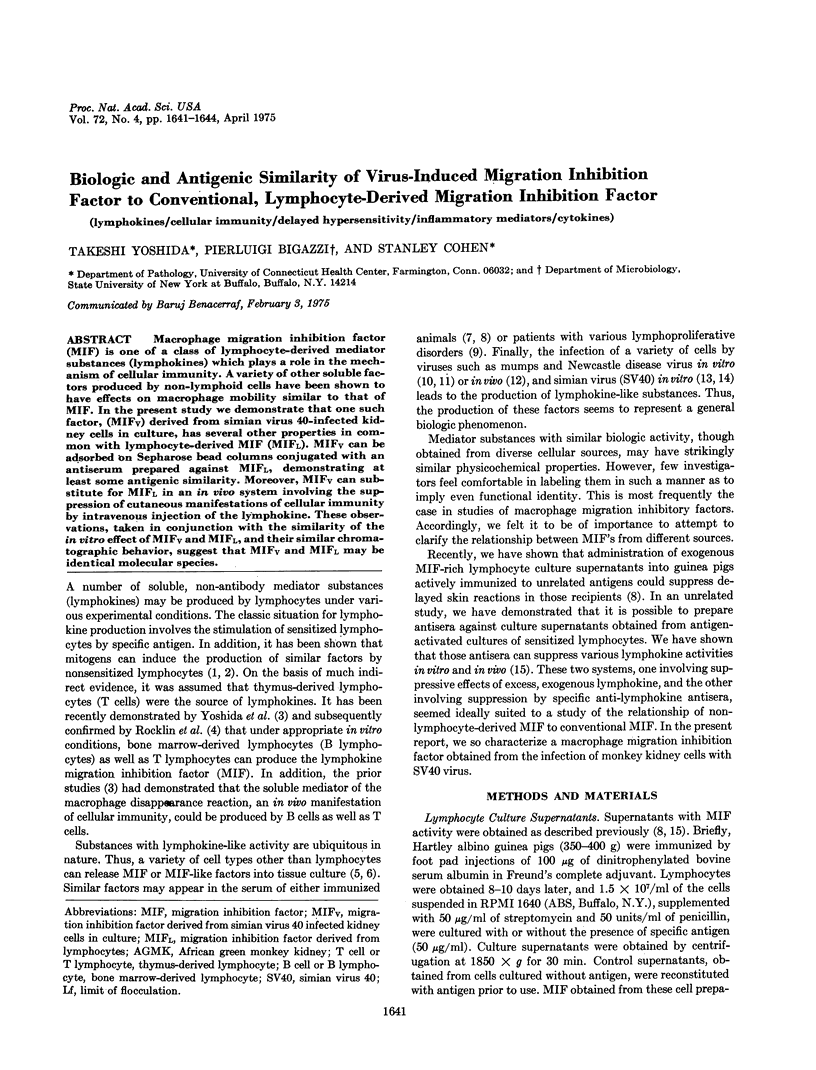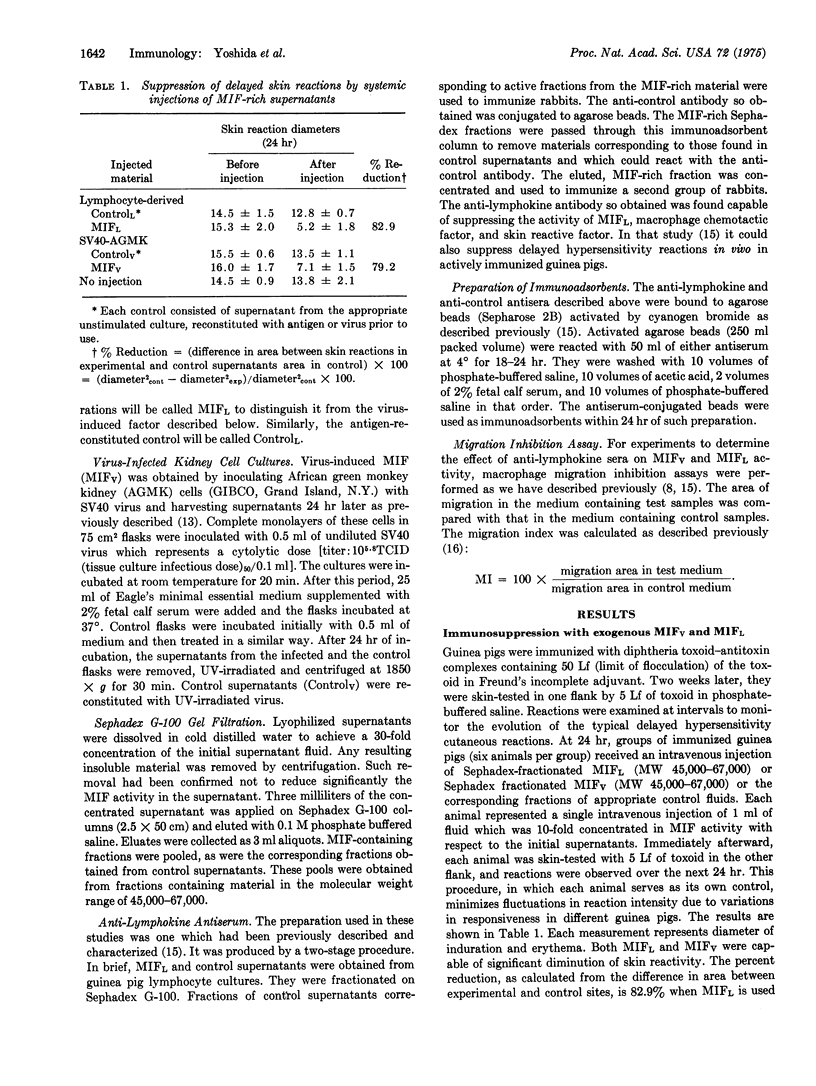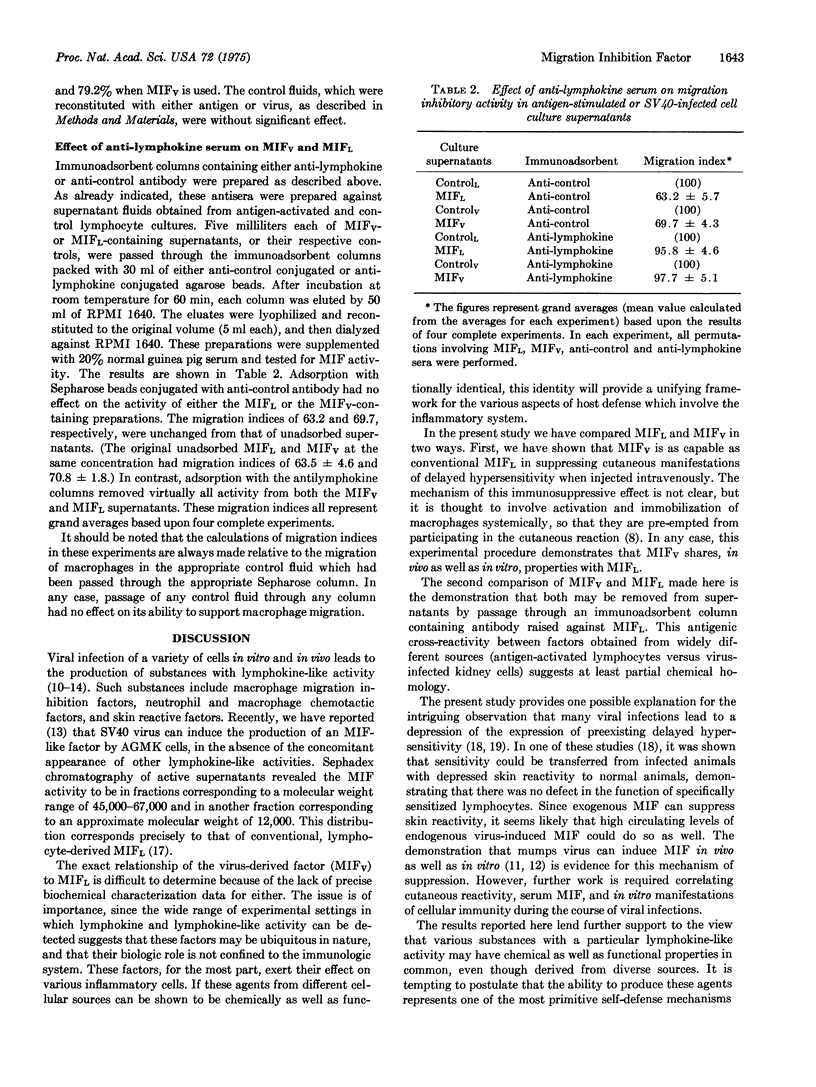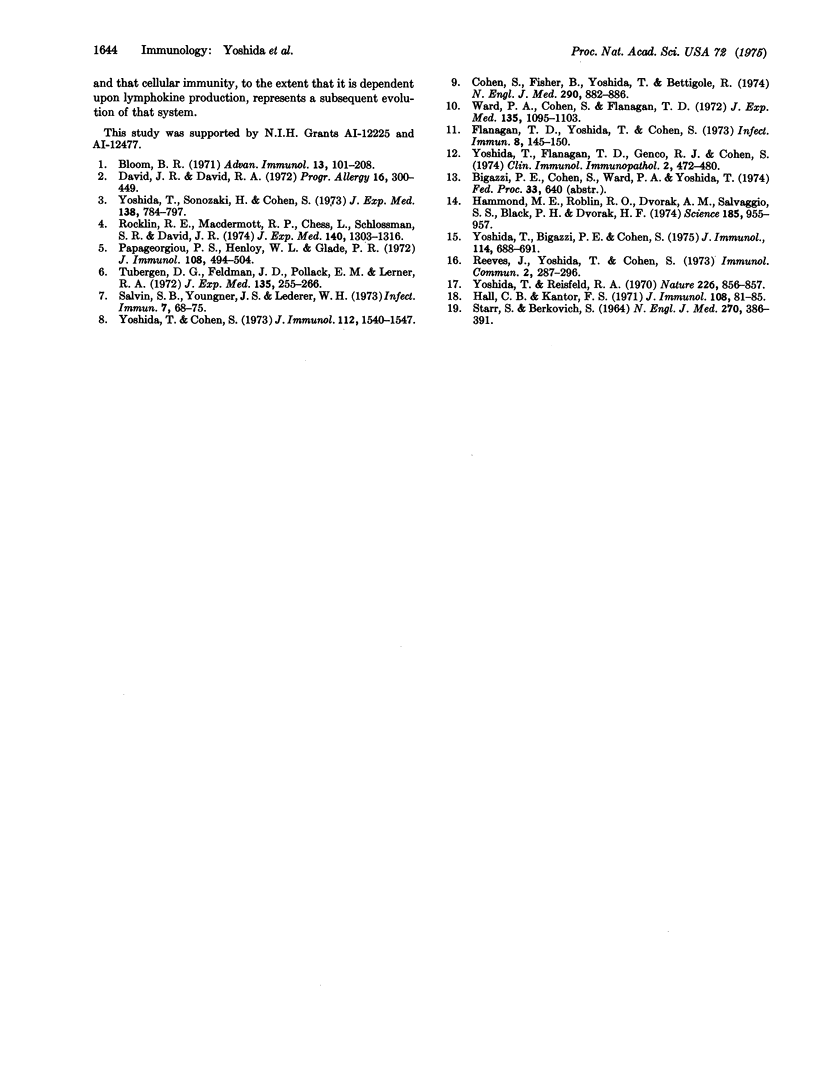Abstract
Macrophage migration inhibition factor (MIF) is one of a class of lymphocyte-derived mediator substances (lymphokines) which plays a role in the mechanism of cellular immunity. A variety of other soluble factors produced by non-lymphoid cells have been shown to have effects on macrophage mobility similar to that of MIF. In the present study we demonstrate that one such factor, (MIFV) derived from simian virus 40-infected kidney cells in culture, has several other properties in common with lymphocyte-derived MIF (MIFL), MIFV can be adsorbed on Sepharose bead columns conjugated with an antiserum prepared against MIFL, demonstrating at least some antigenic similarity. Moreover, MIFV can substitute for MIFL in an in vivo system involving the suppression of cutaneous manifestations of cellular immunity by intravenous injection of the lymphokine. These observations, taken in conjunction with the similarity of the in vitro effect of MIFV and MIFL, and their similar chromatographic behavior, suggest that MIFV and MIFL may be identical molecular species.
Full text
PDF



Selected References
These references are in PubMed. This may not be the complete list of references from this article.
- Bloom B. R. In vitro approaches to the mechanism of cell-mediated immune reactions. Adv Immunol. 1971;13:101–208. doi: 10.1016/s0065-2776(08)60184-4. [DOI] [PubMed] [Google Scholar]
- Cohen S., Fisher B., Yoshida T., Bettigole R. E. Serum migration-inhibitory activity in patients with lymphoproliferative diseases. N Engl J Med. 1974 Apr 18;290(16):882–886. doi: 10.1056/NEJM197404182901605. [DOI] [PubMed] [Google Scholar]
- David J. R., David R. R. Cellular hypersensitivity and immunity. Inhibition of macrophage migration and the lymphocyte mediators. Prog Allergy. 1972;16:300–449. [PubMed] [Google Scholar]
- Flanagan T. D., Yoshida T., Cohen S. Production of macrophage migration inhibition factors by virus-infected cell cultures. Infect Immun. 1973 Aug;8(2):145–150. doi: 10.1128/iai.8.2.145-150.1973. [DOI] [PMC free article] [PubMed] [Google Scholar]
- Hall C. B., Kantor F. S. Depression of established delayed hepersensitivity by mumps virus. J Immunol. 1972 Jan;108(1):81–85. [PubMed] [Google Scholar]
- Hammond M. E., Roblin R. O., Dvorak A. M., Selvaggio S. S., Black P. H., Dvorak H. F. MIF-like activity in simian virus 40-transformed 3T3 fibroblast cultures. Science. 1974 Sep 13;185(4155):955–957. doi: 10.1126/science.185.4155.955. [DOI] [PubMed] [Google Scholar]
- Papageorgiou P. S., Henley W. L., Glade P. R. Production and characterization of migration inhibitory factor(s) (MIF) of established lymphoid and non-lymphoid cell lines. J Immunol. 1972 Feb;108(2):494–504. [PubMed] [Google Scholar]
- Reeves J., Yoshida T., Cohen S. Quantitative aspects of the migration inhibition reaction. Immunol Commun. 1973;2(3):287–296. doi: 10.3109/08820137309022800. [DOI] [PubMed] [Google Scholar]
- Rocklin R. E., MacDermott R. P., Chess L., Schlossman S. F., David J. R. Studies on mediator production by highly purified human T and B lymphocytes. J Exp Med. 1974 Nov 1;140(5):1303–1316. doi: 10.1084/jem.140.5.1303. [DOI] [PMC free article] [PubMed] [Google Scholar]
- STARR S., BERKOVICH S. EFFECTS OF MEASLES, GAMMA-GLOBULIN-MODIFIED MEASLES AND VACCINE MEASLES ON THE TUBERCULIN TEST. N Engl J Med. 1964 Feb 20;270:386–391. doi: 10.1056/NEJM196402202700802. [DOI] [PubMed] [Google Scholar]
- Salvin S. B., Youngner J. S., Lederer W. H. Migration inhibitory factor and interferon in the circulation of mice with delayed hypersensitivity. Infect Immun. 1973 Jan;7(1):68–75. doi: 10.1128/iai.7.1.68-75.1973. [DOI] [PMC free article] [PubMed] [Google Scholar]
- Tubergen D. G., Feldman J. D., Pollock E. M., Lerner R. A. Production of macrophage migration inhibition factor by continuous cell lines. J Exp Med. 1972 Feb 1;135(2):255–266. doi: 10.1084/jem.135.2.255. [DOI] [PMC free article] [PubMed] [Google Scholar]
- Ward P. A., Cohen S., Flanagan T. D. Leukotactic factors elaborated by virus-infected tissues. J Exp Med. 1972 May 1;135(5):1095–1103. doi: 10.1084/jem.135.5.1095. [DOI] [PMC free article] [PubMed] [Google Scholar]
- Yoshida T., Bigazzi P. E., Cohen S. The production of anti-guinea pig lymphokine antibody. J Immunol. 1975 Feb;114(2 Pt 1):688–691. [PubMed] [Google Scholar]
- Yoshida T., Cohen S. Lymphokine activity in vivo in relation to circulating monocyte levels and delayed skin reactivity. J Immunol. 1974 Apr;112(4):1540–1547. [PubMed] [Google Scholar]
- Yoshida T., Reisfeld R. A. Two fractions with macrophage migration inhibitory activity from sensitized lymphocyte cultures. Nature. 1970 May 30;226(5248):856–857. doi: 10.1038/226856a0. [DOI] [PubMed] [Google Scholar]
- Yoshida T., Sonozaki H., Cohen S. The production of migration inhibition factor by B and T cells of the guinea pig. J Exp Med. 1973 Oct 1;138(4):784–797. doi: 10.1084/jem.138.4.784. [DOI] [PMC free article] [PubMed] [Google Scholar]


